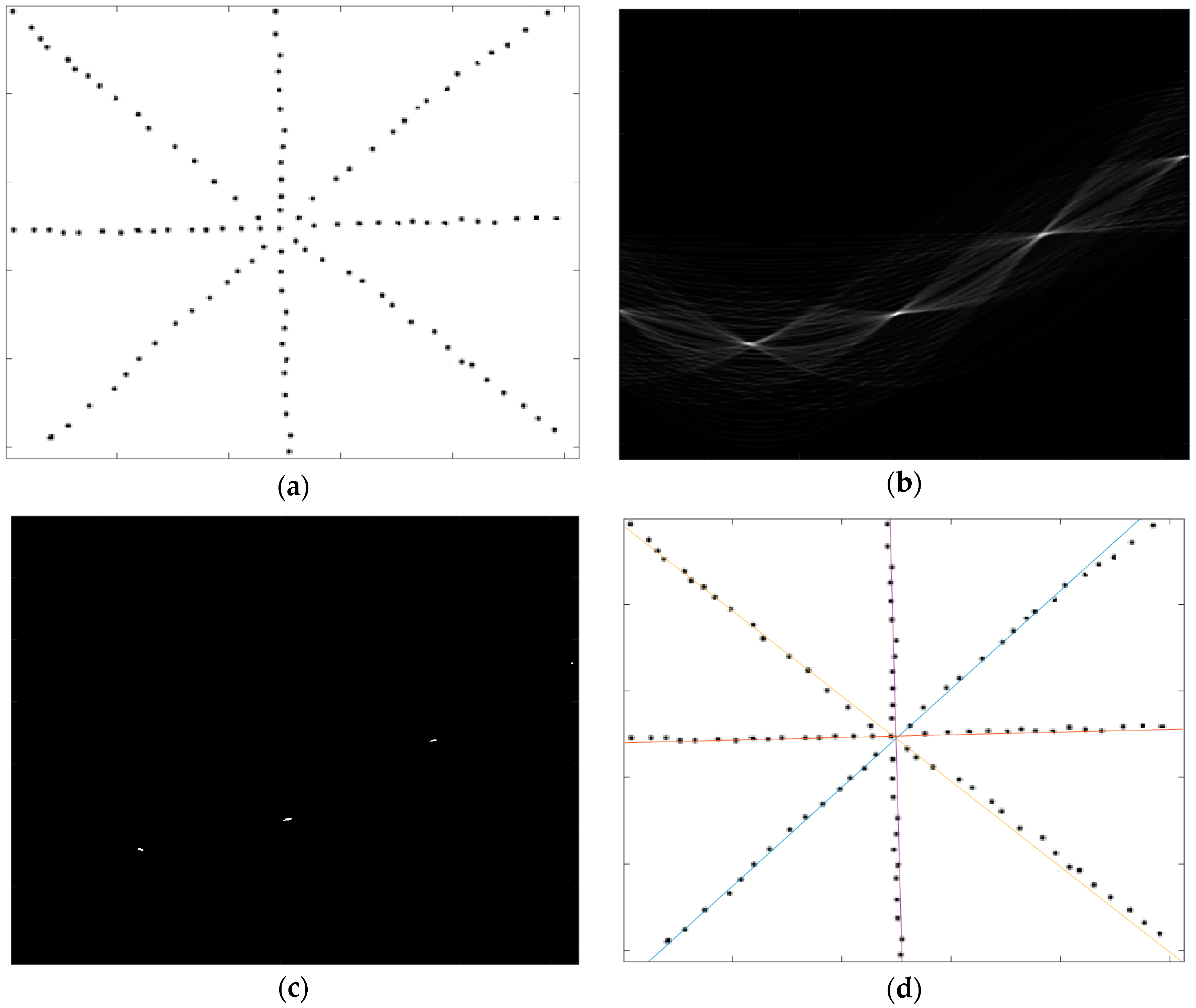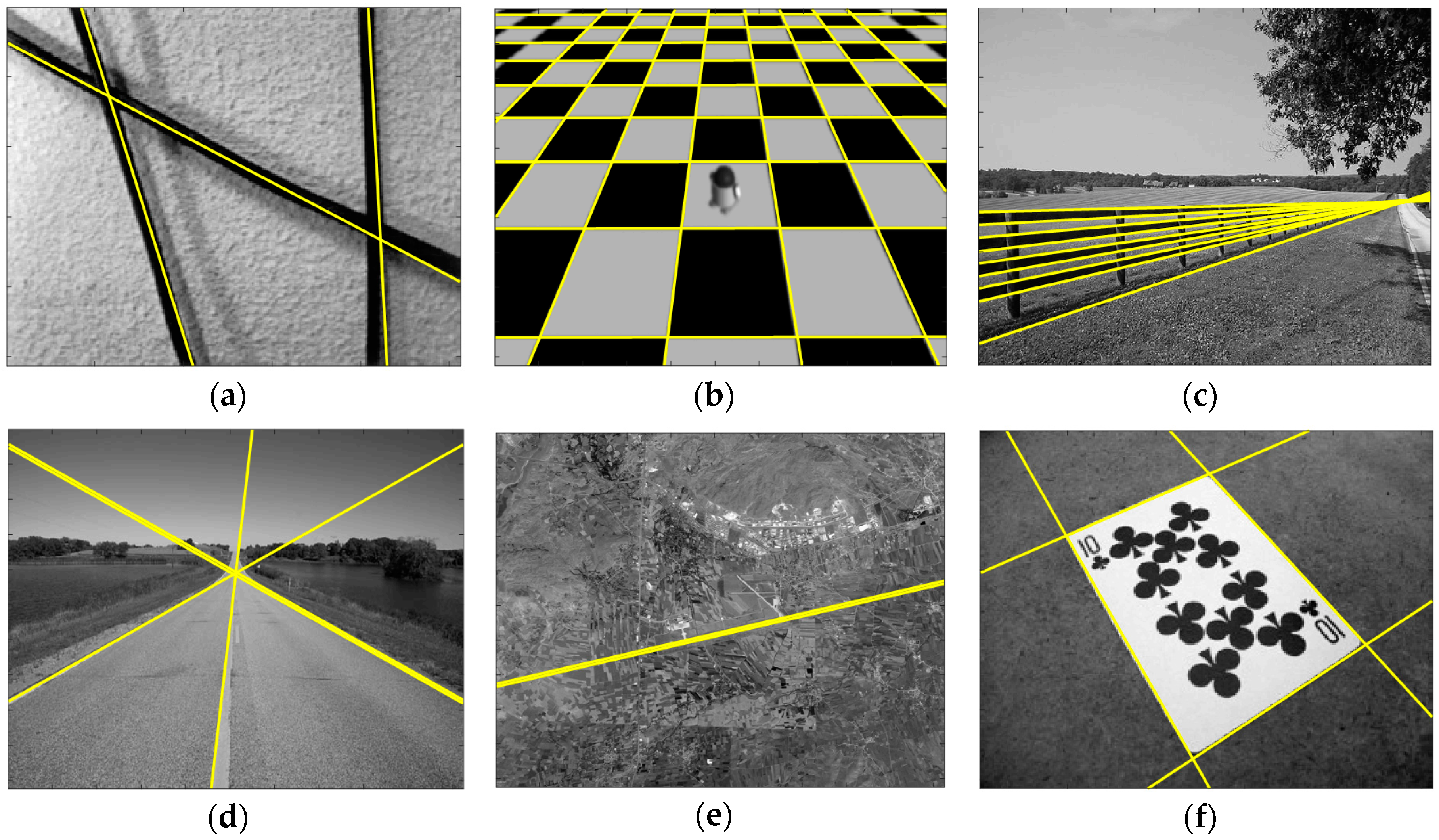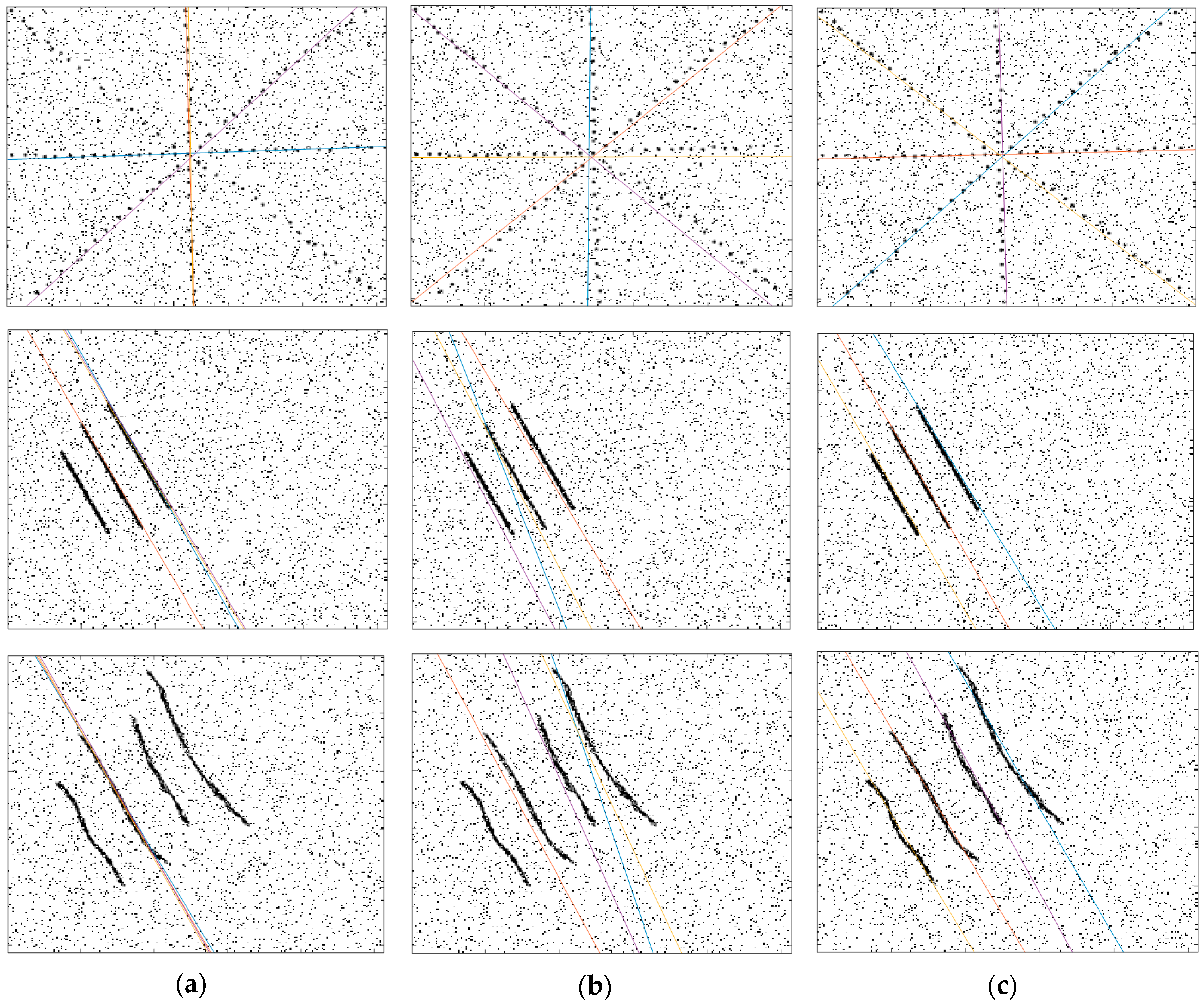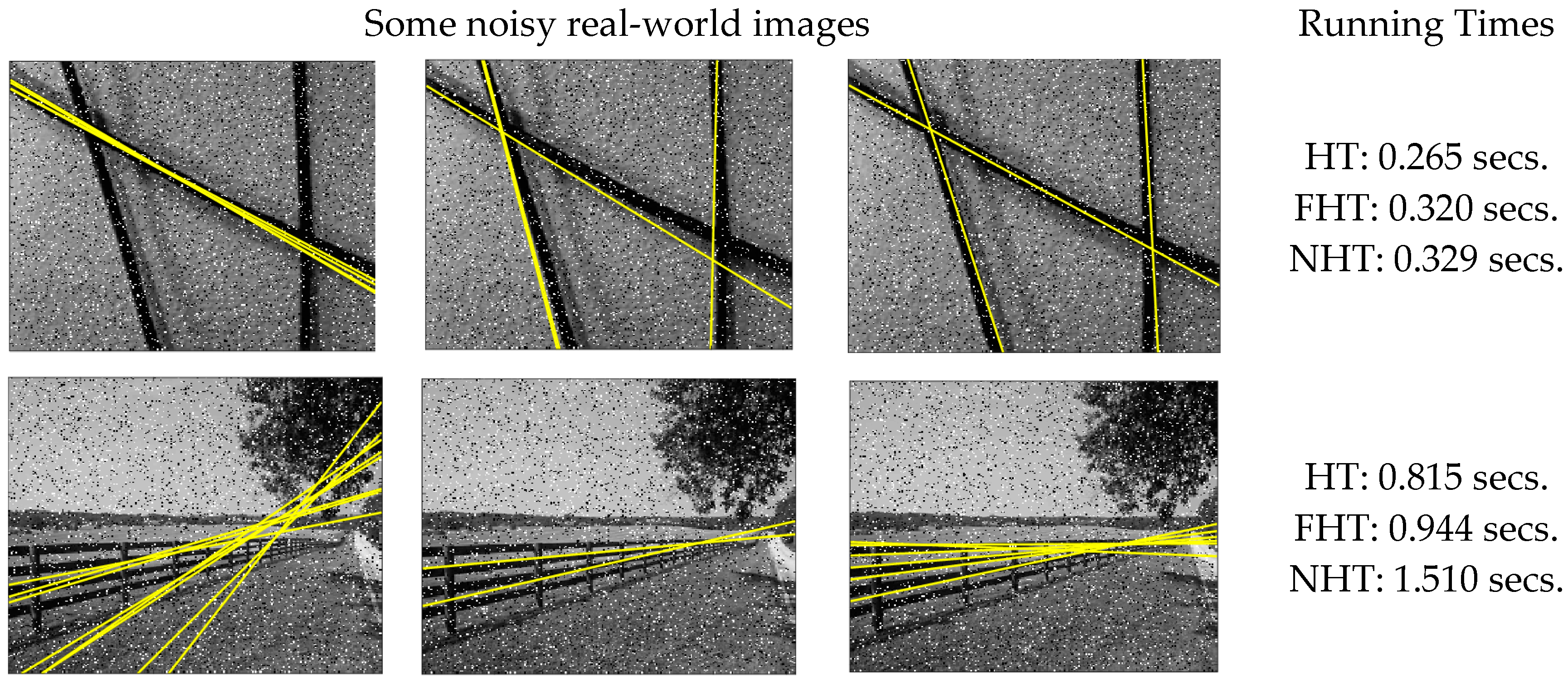1. Introduction
The Hough transform (HT), which is known as a popular pattern descriptor, was proposed in sixties by Paul Hough [
1]. This popular and efficient shape based pattern descriptor was then introduced to the image processing and computer vision community in seventies by Duda and Hart [
2]. The HT converts image domain features (e.g., edges) into another parameter space, namely Hough space. In Hough space, every points (
) on a straight line in the image domain, corresponds a point (
).
In the literature, there have been so many variations of Hough’s proposal [
3,
4,
5,
6,
7,
8,
9,
10,
11,
12,
13,
14]. In [
3], Chung et al. proposed a new HT based on affine transformation. Memory-usage efficiency was provided by proposed affine transformation, which was in the center of Chung’s method. Authors targeted to detect the lines by using slope intercept parameters in the Hough space. In [
4], Guo et al. proposed a methodology for an efficient HT by utilizing surround-suppression. Authors introduced a measure of isotropic surround-suppression, which suppresses the false peaks caused by the texture regions in Hough space. In traditional HT, image features are voted in the parameter space in order to construct the Hough space. Thus, if an image has more features (e.g., texture), construction of the Hough space becomes computationally expensive. In [
5], Walsh et al. proposed the probabilistic HT. Probabilistic HT was proposed in order to reduce the computation-cost of the traditional HT by using a selection step. The selection step in probabilistic HT approach just considered the image features that contributed the Hough space. In [
6], Xu et al. proposed another probabilistic HT algorithm, called randomized HT. Authors used a random selection mechanism to select a number of image domain features in order to construct the Hough space parameters. In other words, only the hypothesized parameter set was used to increment the accumulator. In [
7], Han et al. used the fuzzy concept in HT (FHT) for detecting the shapes in noisy images. FHT enables detecting shapes in noisy environment by approximately fitting the image features avoiding the spurious detected using the traditional HT. The FTH can be obtained by one-dimensional (1-D) convolution of the rows of the Hough space. In [
8], Montseny et al. proposed a new FHT method where edge orientations were considered. Gradient vectors were considered to enable edge orientations in FHT. Based on the stability properties of the gradient vectors, some relevant orientations were taken into consideration, which reduced the computation burden, dramatically. In [
9], Mathavan et al. proposed an algorithm to detect cracks in pavement images based on FHT. Authors indicated that due to the intensity variations and texture content of the pavement images, FHT was quite convenient to detect the short lines (cracks). In [
10], Chatzis et al. proposed a variation of HT. In the proposed method, authors first split the Hough space into fuzzy cells, which were defined as fuzzy numbers. Then, a fuzzy voting procedure was adopted to construct the Hough domain parameters. In [
11], Suetake et al. proposed a generalized FHT (GFHT) for arbitrary shape detection in contour images. The GFHT was derived by fuzzifying the vote process in the HT. In [
12], Chung et al. proposed another orientation based HT for real world applications. In the proposed method, authors filtered out those inappropriate edge pixels before performing their HT based methodology. In [
13], Cheng et al. proposed an eliminating- particle-swarm-optimization (EPSO) algorithm to reduce the computation cost of HT. In [
14], Zhu et al. proposed a new HT for reducing the computation complexity of the traditional HT. The authors called their new method as Probabilistic Convergent Hough Transform (PCHT). To enable the HT to detect an arbitrary object, the Generalized Hough Transform (GHT) is the modification of the HT using the idea of template matching [
15]. The problem of finding the object is solved by finding the model’s position, and the transformation’s parameter in GHT.
The theory of neutrosophy (NS) was introduced by Smarandache as a new branch of philosophy [
16,
17]. Different from fuzzy logic, in NS, every event has not only a certain degree of truth, but also a falsity degree and an indeterminacy degree that have to be considered independently from each other [
18]. Thus, an event or entity {A} is considered with its opposite {Anti-A} and the neutrality {Neut-A}. In this paper, we proposed a novel HT algorithm, namely NHT, to improve the line detection ability of the HT in noisy environments. Specifically, the neutrosophic theory was adopted to improve the noise consistency of the HT. To this end, the Hough space is initially transferred into the NS domain by calculating the NS memberships. A filtering mechanism is adopted that is based on the indeterminacy membership of the NS domain. This filter considers the neighborhood information in order to remove the indeterminacy in the spatial neighborhood of Hough space. A peak search algorithm on the Hough space is then employed to detect the potential lines in the image domain. Extensive experiments on noisy and noise-free images are performed in order to show the efficiency of the proposed NHT algorithm. We further compare our proposed NHT with traditional HT and FHT methods on a variety of images. The obtained results show the efficiency of the proposed NHT on both noisy and noise-free images.
The rest of the paper is structured as follows:
Section 2 briefly reviews the Hough transform and fuzzy Hough transform.
Section 3 describes the proposed method based on neutrosophic domain images and indeterminacy filtering.
Section 4 describes the extensive experimental works and results, and conclusions are drawn in
Section 5.
4. Experimental Results
In order to specify the efficiency of our proposed NHT, we conducted various experiments on a variety of noisy and noise-free images. Before illustration of the obtained results, we opted to show the effect of our proposed NHT on a synthetic image. All of the necessary parameters for NHT were fixed in the experiments where the sigma parameter and the window size of the indeterminacy filter were chosen as 0.5 and 7, respectively. The value of a and b in Equation (11) are set as 0.5 by the trial and error method.
In
Figure 2, a synthetic image, its NS Hough space, detected peaks on NS Hough space and the detected lines illustration are illustrated below.
As seen in
Figure 2a, we constructed a synthetic image, where four dotted lines were crossed in the center of image. The lines are designed not to be perfectly straight in order to test the proposed NHT.
Figure 2b shows the NS Hough space of the input image. As seen in
Figure 2b, each image point in the image domain corresponds to a sinus curve in NS Hough space, and the intersections of these sinus curves indicate the straight lines in the image domain. The intersected curves regions, as shown in
Figure 2b, were detected based on the histogram thresholding method and the exact location of the peaks was determined by finding the center of the region. The obtained peaks locations are shown in
Figure 2c. The obtained peak locations were then converted to lines and the detected lines were superimposed in the image domain, as shown in
Figure 2d.
We performed the above experiment one more time when the input synthetic image was corrupted with noise. With this experiment, we can investigate the behavior of our proposed NHT on noisy images. To this end, the input synthetic image was degraded with a 10% salt & pepper noise. The degraded input image can be seen in
Figure 3a. The corresponding NS Hough space is depicted in
Figure 3b. As seen in
Figure 3b, the NS Hough space becomes denser when compared with the
Figure 2b, because the all of the noise points contributed the NS Hough space. The thresholded the NS Hough space is illustrated in
Figure 3c, where four peaks are still visible. Finally, as seen in
Figure 3d, the proposed method can detect the four lines correctly in a noisy image. We further experimented on some noisy and noise-free images, and the obtained results were shown in
Figure 4. While the images in the
Figure 4a column show the input noisy and noise-free images, in
Figure 4b column, we give the obtained results. As seen in the results, the proposed NHT is quite effective for both noisy and noise-free images. All of the lines were detected successfully. In addition, as shown in the first row of
Figure 4, the proposed NHT could detect the lines that were not straight perfectly.
As the proposed NHT was quite good in detection of the lines in both noise and noise-free synthetic images, we performed some experiments on gray scale real-world images. The obtained results were indicated in
Figure 5. Six images were used and obtained lines were superimposed on the input images. As seen from the results, the proposed NHT yielded successful results. For example, for the images of
Figure 5a,c–f, the NHT performed reasonable lines. For the chessboard image (
Figure 5b), only few lines were missed.
We further compared the proposed NHT with FHT and the traditional HT on a variety of noisy images and obtained results were given in
Figure 6. The first column of
Figure 6 shows the HT performance, the second column shows the FHT achievements, and final column shows the obtained results with proposed NHT.
With visual inspection, the proposed method obtained better results than HT and FHT. Generally, HT missed one or two lines in the noisy environment. Especially for the noisy images that were given in the third row of
Figure 6, HT just detected one line. FHT generally produced better results than HT. FHT rarely missed lines but frequently detected the lines in the noisy images due to its fuzzy nature. In addition, the detected lines with FHT were not on the ground-truth lines, as seen in first and second rows of
Figure 6. NHT detected all of the lines in all noisy images that were given
Figure 6. The detected lines with NHT were almost superimposed on the ground-truth lines as we inspected it visually. In order to evaluate the comparison results quantitatively, we computed the
F-measure values for each method, which is defined as:
where precision is the number of correct results divided by the number of all returned results. The recall is the number of correct results divided by the number of results that should have been returned.
To this end, the detected lines and the ground-truth lines were considered. A good line detector produces an
F-measure percentage, which is close to 100%, while a poor one produces an
F-measure value that is closer to 0%. As
Figure 6 shows the comparison results, the corresponding
F-measure values were tabulated in
Table 1. As seen in
Table 1, the highest average
F-measure value was obtained by the proposed NHT method. The second highest average
F-measure value was obtained by FHT. The worst
F-measure values were produced by HT method.
We also experimented on various noisy real-world images and compared the obtained results with HT and FHT achievements. The real-world images were degraded with a 10% salt & pepper noise. The obtained results were given in
Figure 7. The first, second, and third columns of
Figure 7 show the HT, FHT, and NHT achievement, respectively. In addition, in the last column of
Figure 7, the running times of each method for each image were given for comparison purposes.
As can be seen in
Figure 7, the proposed NHT method is quite robust against noise and can able to find the most of the true lines in the given images. In addition, with a visual inspection, the proposed NHT achieved better results than the compared HT and FHT. For example, for the image, which is depicted in the first row of
Figure 7, the NHT detected all of the lines. FHT almost detected the lines with error. However, HT only detected just one line and missed the other lines. Similar results were also obtained for the other images that were depicted in the second and third rows of the
Figure 7. In addition, for a comparison of the running times, it is seen that there is no significant differences between the compared methods running times.














